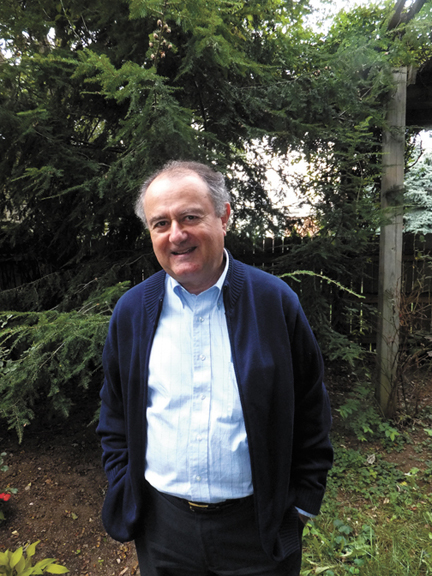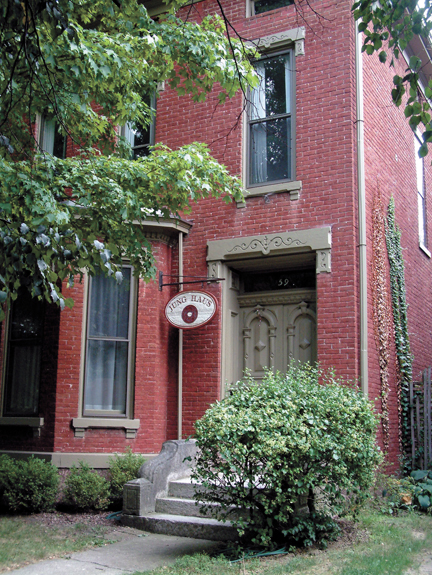
Columbus, Ohio USA
Return to Homepage www.shortnorth.com
Richard Sweeney and the Junghaus
Analyst continues spiritual journey in Columbus after 20 years
By Ann Starr
October 2014 Issue
See Also: 20 Years of Spiritual Reflection
Return to Homepage
Return to Features Index
Richard Sweeney Photo © Gus Brunsman III Before I met Richard Sweeney – whose twentieth anniversary as their beacon the Columbus Jungian community celebrates this year – I had been told by the staff of the JungHaus that his intellectual brilliance is matched by his willingness to serve as light bulb changer; his patience for investigating life’s meaning is equaled by his nimble handling of the Jung Association’s folding step ladder. This appears to be true.
Sweeney’s psychoanalytic practice is located on West Third Avenue in the Short North, in a lovingly restored nineteenth-century house. His office and the offices of three other analysts occupy the high second floor. The first floor, with its tall windows and elegant, plastered ceilings, houses the library, art gallery, and the offices of JACO – the C.G. Jung Association of Central Ohio. At the farthest reach of the house is a white and sparely furnished meditation room that overlooks the green yard and garden. These public rooms of the house exude a special air of mingled calm and energy.
Before there was Sweeney in Columbus (1993), there was JACO. Carl Jung’s philosophy of collective unconscious, archetypes, and the interpretation of dreams had prompted the interest of local people who began meeting in the late 1980s to discuss Jung’s insights and to share personal experiences. Gina Peacock, JACO’s director, warmly characterizes the core group as “interesting people – people who talk about life and experience, and who wanted to make good connections with others interested in substantial issues. They were intrigued by Jung’s ideas.”
JACO formed itself as a non-profit, then met and held member-organized discussions and programs at two early locations in the Short North. They found their real home on West Third Avenue once Sweeney and his wife Ellen – analysts both – accepted the invitation to begin practicing in Columbus, which had until then lacked any Jungian psychoanalysts at all. The Sweeneys purchased the property in consultation with JACO staff, with the intention of its becoming what it is today: a meeting space and library for anyone exploring Jungian thought and its offshoots, gallery space for expressive art, and office space for psychoanalysts. So even though the Sweeneys and JACO are not formally associated, the power that Jung’s ideas exert over all brings them together spiritually, intellectually, and very literally.***
When I spoke to Sweeney in his office to begin this profile, I had to ask first about the profession that defines his importance in the community. What is a Jungian analyst, particularly in the larger context of mental health professionals? A psychoanalyst is not the same as a psychiatrist, but I felt sure that I was not alone in wondering what, precisely, the distinctions are. He was happy to clarify.
Psychiatrists are medical doctors with the M.D. degree. They diagnose and treat mental disorders as defined by the Diagnostic and Statistical Manual, currently the DSM-V. Less often than before, psychiatrists provide talk therapy; most important of all currently, they prescribe medications.
Psychoanalysts are fully aware of the scope of psychiatry and know when the diagnostic and prescriptive skills of a doctor are needed for their patients. Their work – often complemented by the psychiatrist’s – is to help the sufferer look into the depths of her or his unconsciousness to find the sources of the problems that cause them pain or block their ability to move forward in life. The analyst works not with brain chemistry, but with what people reveal in their dreams, emotional conflicts, fantasies, and repeated patterns in everyday life. The goal is to help clients realize themselves by “depotentiating” (even Sweeney smiles over the professional term) the conflicts, fears, vices, or other impediments that prevent self-discovery and individual problem solving.
Analysts come to their training from every direction and background. Some are psychiatrists, social workers, or in other related health or welfare professions, but such a background is not required. The work is therapeutic, but not diagnostic in the sense of labeling or categorizing.***
How many of us devote our time to the pursuit of meaning in life? Don’t we let philosophers and artists do that for us? Not always, but often, people seek the aid of therapists when in crisis – in the circumstances most threatening to one’s sanity and ability to carry on. What kind of person sits patiently with a roster of people in acute need, to listen deeply and ask respectful, effective questions? Analysis is not a job for people of fluctuating self-control or wavering compassion. It’s no wonder that the JACO staff speak with some awe of Sweeney’s manifest mortality in changing light bulbs: It’s difficult not to deify another human whose daily work demands qualities most of us count as unattainable virtues.
But his concern with spiritual inquiry has driven Sweeney throughout his adulthood. As a young man, he was called to the Roman Catholic priesthood. He was appointed to the Archdiocese of Cincinnati in 1974 and served for nineteen years.
The JungHaus at 59 West Third Avenue. Photo © Gus Brunsman III In 1978, Sweeney was appointed to direct continuing education for all the priests in the diocese of four hundred. In support of his work, and with the encouragement of his Archbishop, Joseph Bernardin (later Cardinal Archbishop of Chicago) Sweeney went to Berkeley, California, where he entered the Graduate Theological Union. There he spent four years, earning his Ph.D. in psychology and spirituality. He returned to St. Mary’s School of Theology in Cincinnati, obtained his license as a professional clinical counselor, and served as teacher and counselor to both the priests and lay students of the school.
Asked if there was any institutional discomfort about the relationship between professional social science and religious counseling, Sweeney is easy with the question. “I felt that our spiritual and psychological selves were interwoven. I didn’t feel it as a conflict, because of my study of Jungian psychology, where there is a central correlation of psychological and spiritual.”
For five years, Sweeney served as Academic Dean at St. Mary’s, happy in the Church to which he had been called and ordained. “There was a lot of openness in the Church – openness to revision; openness to dialogue, to debate, and to other religions. But everything closed down under John Paul II.” After John Paul II’s election in 1978, Sweeney felt himself increasingly in conflict with a narrowing Church outlook.
In 1990, Sweeney was due a year’s sabbatical, which he chose to take at the C.G. Jung Institute in Zurich, Switzerland. He remained three years, filling the position of pastor to the English-speaking local community during his studies at the Institute.
The doubts that had taken hold in Sweeney since the beginning of the new papacy did not abate, though, in Zurich. The Church’s resistance to dialogue and debate rankled. During this period, he also met Ellen, another analyst in training, and his future wife. Sweeney’s doubts about a lifelong commitment to celibacy became conviction. In 1993 he left the priesthood. “The inner call that led me into the priesthood led me out,” he puts it simply. “It was a movement of the spirit.
“As a priest, I felt called to help people; I felt that I was helping them build a relationship with God. That changed to helping them find their authentic selves. I began to see that the two were the same.”
***
We conversed in Sweeney’s second-story office in the gracious house on West Third Avenue. We sit opposite one another, each in a capacious, protective, blonde leather chair. This is a space in which professional counselors usually betray nothing to the person seated across from them, so I listen to the story of his taking profound chances while I watch his face. Yes, I’ve been in this chair before, looking for reflection in the face of my professional interlocutor, someone trained in not-giving-reflections. So I am moved by Sweeney’s sharing of these details about a considered journey – one that requires effort of will applied against the inertia of satisfaction; the facing of deniable doubts; and the exertion of strength to move forward.
Sweeney has a broad, friendly, and plain face, more engaged in observing than in exposing the nature behind it. The small movements of eyebrows and facial muscles, the fleeting rueful appeal in the eyes that suggest doubt and dark nights – all reveal a determined person focused on reality. This is someone who doesn’t expect perfection, but all that one can give: Effort. I wonder if he gets dizzy on the ladder he so obligingly climbs. He’d never give it away if he does. We’d have to ask.
How does anyone live the life of an analyst without becoming overburdened? Sweeney suggests that, because it’s so intense a job, he is careful to manage its position in his life. He doesn’t work weekends or evenings. He has a son in high school. He and Ellen love attending their son’s activities and supporting his interests. Sweeney is a passionate tennis player; he loves swimming. Though they are not a family of travelers, they enjoy spending time renting retreats in Maine.***
Inside JungHaus, next to the front door, there is a bronze plaque with a Latin inscription: Vocatus atque non vocatus deus aderit. This is the Latin translation of a Greek inscription found on the Temple of Apollo at Delphi, which Jung appropriated for his own house, Bollingen. “Called or not called, the god will be there.”
Sweeney quoted this to me first when I asked him about the use of imagery and the favored place of art in Jungian practice.
Indeed, the West Third Avenue site was chosen in significant part because of its suitability as an art gallery, where an exhibit is nearly always on view, often showing work by JACO members, friends, or Jungian adherents. Claire Hagan Bauza, the gallery’s longtime director, told me that the gallery is not only well-used, but is constantly visited. Some of the artists would show nowhere else because they know that their work will be genuinely seen in that place, seen “with a caring eye.” Many people show work prompted by episode on difficult life journeys, or by new levels of awareness.
Sweeney’s valuing of the gallery must be more than a matter of Jungian analytic practice and theory. It shows awareness of the difficulty of his own experience – his own long journey of integrity and self-awareness. Sweeney has built a hut for fellow travelers, a place to rest and take stock, where they can consider how far they’ve come. He’s been there too, struggling to find the way.Among events celebrating JACO’S 25th Anniversary and Richard Sweeney’s 20 years as an analyst at the JungHaus are a members’ exhibit in the gallery throughout October and Richard Sweeney’s lecture and workshop, “The Soul as Transformative Process” on October 10-11. Visit www.jungcentralohio.org for information.
© 2014 Short North Gazette, Columbus, Ohio. All rights reserved.
Return to Homepage www.shortnorth.com

